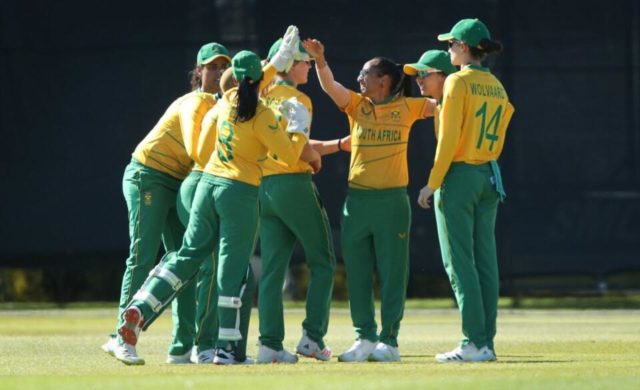After enduring a tour to England that went badly, the Proteas Women’s team will need to evolve for them to be not left behind by the rest of the world.
Johannesburg – On the same day that the national women’s football returned home after achieving continental success, 13,000km north, their cricketing counterparts were reflecting on a tour gone badly, and how that may affect their chances at the Commonwealth Games.
The multi-format series against England – the first South Africa has played in – was a chastening experience for a group of players used to success in recent years.
While they’ve yet to hold a global title – or even play a final – there’s been a consistency in performance that has seen them reach two 50 over World Cup semi-finals and the last four of the T20 World Cup two years ago.
ALSO READ: Marizanne Kapp bows out of Commonwealth games
Those results were the culmination of growth among a core of players, who for various reasons, didn’t play in all the matches in England.
That meant a younger, less experienced group was roped into the starting eleven and their tentativeness was evident as the Proteas were overwhelmed by an English team, which itself is going through a transition.
#MomentumProteas batter Tazmin Brits reflect on her half-century and what lessons the team has learnt during the T20I series against England 🇿🇦#ENGvSA #AlwaysRising #BePartOfIt pic.twitter.com/A4jKU9Tyqu
— Cricket South Africa (@OfficialCSA) July 26, 2022
The differences however between England’s younger players and South Africa’s were stark. The likes of Izzy Wong — who is going to be the women’s game’s next superstar — Lauren Bell, Emma Lamb and the two 17-year-olds Alice Capsey and Freya Kemp, played with freedom and pizazz.
ALSO READ: Proteas Women struggle without Kapp in first T20
Crucially, they played according to a game plan that encourages an aggressive style.
England can do that, because through its domestic structures and the local competitions, they have a good idea of the kind of talent coming through and can expose them in competitions, like The Hundred.
South Africa, as Laura Wolvaardt pointed out after the first T20 International, needs to do a lot of investment.
“We have a lot of our girls here who are getting their first exposure to players of this high a level, international quality bowlers, playing on TV and playing in front of crowds. It is definitely a concern and something I hope people are looking at for the future, ” said Wolvaardt who along with Marizanne Kapp and Chloe Tryon, were South Africa’s best three players across the series’s.
Enoch Nkwe, Cricket SA’s Director of Cricket, who is currently in England, where he is scheduled to meet with the players and the coaching staff, has indicated that a special emphasis would be placed on the women’s game, with CSA set to interrogate the structures and find areas where it can be strengthened.
That is a long term process. There is however little time ahead of the Commonwealth Games, with South Africa’s first game on Saturday, as well as the T20 World Cup, a marquee event on the South African cricket calendar next summer.
While the standard of South Africa’s play against England was a concern, even more worrying was the absence of any evolution in how they play.
Australia advanced the women’s game at the World Cup in New Zealand, where an adventurous and more aggressive style of play, particularly with the bat, provided the foundation for their success.
England have made no secret of following that method and have armed their players with the right attitude to allow them to lay more freely. Heather Knight, the England captain, mentioned being ‘super aggressive’ in the power play.
Throughout the T20 series, the hosts simply blew South Africa away in the first six overs, topping 50 in each match. South Africa’s best power play total was 44/1 which came in the last match.
Obviously Lizelle Lee’s retirement left a massive hole at the top of the order, but more than that it was the fact that South Africa didn’t appear to be as clear about their plan or how they hoped to advance their game post the 50-over World Cup, as England have been.
That is something for head coach Hilton Moreeng and the rest of his coaching to think about. With Kapp no longer available for the Commonwealth Games, owing to her family trauma, South Africa’s medal chances have taken a significant blow.
However, with the T20 World Cup on home soil in mind, the Games offer a chance to implement a new aggressive attitude. In Wolvaardt, Tryon and the veteran Mignon du Preez, South Africa has an experienced trio around whom their batting strategy can be built.
It will demand some out of the box thinking, and tinkering with the batting order, but South Africa can ill-afford the same tired, tentative batting plan that’s been seen the last few weeks against England.
The game has moved on, and the Proteas, need to buckle up and get moving with it.








